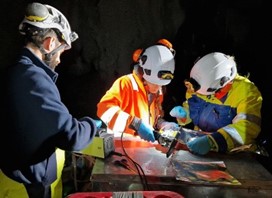Radioactive waste disposal is a major societal challenge facing all countries that use nuclear power. The high-level waste is mostly composed of spent nuclear fuel assemblies while low- and intermediate-level waste includes waste from the operation and dismantling of nuclear power plants as well as industry, medicine and research. In Switzerland, the waste will be buried in deep geological repository location within a rock formation called Opalinus Clay. Within the repository, the tunnels will be backfilled with a clay, bentonite.
H2 consumption in the repository
 |
 |
H2 gas production is expected from the anoxic corrosion of steel container (holding waste). To prevent the accumulation of H2, we propose to provide space in the repository for microorganisms to grow and consume the gas. The project focuses on three aspects: (a) quantifying the rate of microbial H2 consumption; (b) identifying the microorganisms responsible for H2 consumption; (c) ensuring that this process does not impact the integrity of the waste canisters (i.e., protection from sulfide).
This project uses a combination of engineering, microbiology, and geochemical techniques including metagenomics, synchrotron-based spectroscopy tools. The gas phase is continuously monitored to extract H2 consumption rates. The work is conducted at the Mt Terri Underground Rock Laboratory in St Ursanne.
People: Camille Rolland (Ph.D. student)
Funding: NAGRA
Microbial growth and metabolism in clay
Clay is a unhospitable environment for microorganisms due to the small pore size, the swelling pressure and the low water activity. For radioactive waste disposal, bentonite clay is used to inhibit microbial growth in the vicinity of steel containers to preclude microbially-induced corrosion. However, there remain questions about the clay density at which microbial growth stops. In this project, we investigate the factors controlling microbial growth in bentonite clay, including density and the presence of atmospheric oxygen.
 |
 |
The Kiruna magnetite mine is a natural analog to deep geological repositories due to the presence of bentonite clay and magnetite. This project focuses on identifying microbial life in a Clay rock that formed >800 million years ago.
For these two projects, we use a combination of tools stemming from engineering (microcosm reactors), microbial ecology, mineralogy, and geochemistry and include a subsurface field component (Kiruna Mine, Mt Terri Underground Rock Laboratory).

People: Natalia Jakus (post-doc)
Funding: EURAD, EURAD2, NAGRA